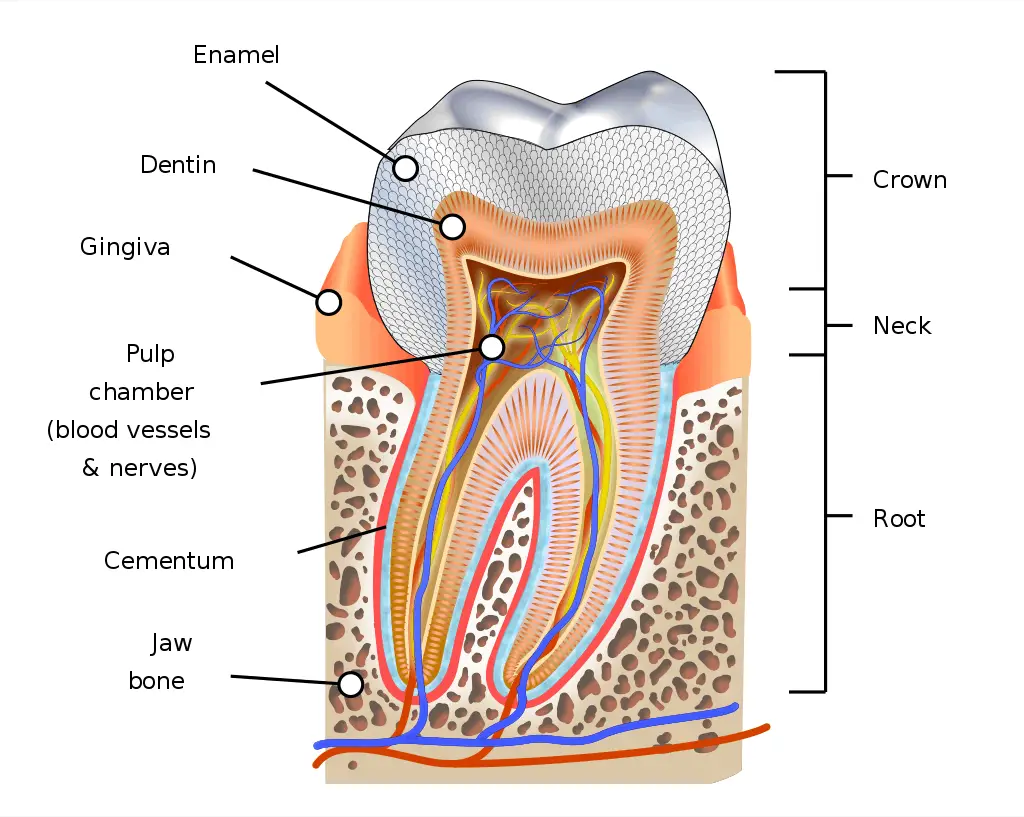
When discussing whitening treatments and options with my patients in my dental chair, pain and sensitivity are among the top things discussed. Either they have heard about zingers, or they’ve experienced them in the past. Zingers after teeth whitening can be extremely painful, and can leave you desperate for relief, but what causes them?
Zingers after/during teeth whitening treatments occur when hydrogen peroxide dehydrates and penetrates the tooth and irritates the tooth nerve, causing sharp nerve pain. You may feel zingers in just one tooth or multiple teeth and should dissipate 24-48 hours after the whitening treatment.
There are differing degrees of pain during and after teeth whitening, and often it comes down to the prep work that is done before whitening to prepare the teeth for whitening treatments that I will go over with you in this post. Doing this small step can make all the difference in the severity of zingers experienced.
In this post, I delve deeper into the causes of zingers, how to prevent them, and how to deal with them after the whitening treatment!
Causes of zingers after and during teeth whitening
I just want to start by saying that the only substance that will actually whiten and change the colour of your tooth is hydrogen peroxide. It may also be listed as carbamide peroxide, as carbamide peroxide breaks down into hydrogen peroxide and urea when it comes into contact with water.
If your at-home whitening treatments do not contain peroxide, IT WILL NOT WHITEN YOUR TEETH! I repeat… it will not whiten your teeth.
I am so disappointed in brands that push whiting products that frankly will not work, but they have paid people to promote them who are not dental professionals, and those who don’t know any better.
Another farce…. lights. The LED or any light that a whitening kit comes with has absolutely ZERO effect on the effectiveness of the whitening gel.
Please stay away from these products. It saddens me because even big brand name companies are selling these lights that again have no purpose and do nothing but pollute and cause more waste.
Okay, rant ended. 🙂
“Whitening” products such as toothpaste, gum, floss, rinses, and toothbrushes should be avoided at all costs because they are either abrasive and will take away the irreplaceable tooth surface or just won’t work. (“Whitening” is in brackets because the products I listed do not whiten/change the colour of the tooth).
Let me tell you a sad/shocking story of one of my patients.
This man was in his 40’s and had not been to see me in 3-4 years due to his reasons. When he came in to see me, his chief complaint was that his front teeth were super yellow! I took a look at his front teeth, and he had lost all the surface enamel on the front surface of his front teeth, exposing the yellow dentin underneath.
By asking him a few questions to try and figure out what caused this, I asked him if he was using a whitening toothpaste. He said YES! And he was even brushing his front teeth at lunch at work, to try and reduce the yellow colour.
I explained to him that whitening toothpastes don’t actually work to change the colour of the teeth, but use abrasives to scrub away any surface stain on the teeth, which takes off microscopic layers of the tooth surface.
He was shocked and mad (not at me) but at the whitening toothpaste companies which don’t have to disclose this information on the box.
He just wanted his front teeth to be white, and the only options he had were to either get crowns (which cover the entire crown of the tooth like a helmet) or veneers (which cover only the front surfaces of the crown of the tooth like a fake fingernail).
This is why I am so passionate about letting people know the dangers of different whitening products on the market!
The reason why zingers occur is as follows;
Why hydrogen peroxide causes tooth zingers
Hydrogen peroxide can easily and safely penetrate the tooth surface and break down the molecules that reflect light and make the tooth appear dark/discoloured.
To get a bit more into the science, when the peroxide is absorbed by the tooth, it begins to oxidize and takes the electrons from the atoms, which in turn breaks down the stain molecules.
As this oxidization happens, and the peroxide penetrates further into the tooth, it gets closer to the pulp chamber of the tooth that houses all the nerves and blood vessels that give vitality to the tooth.

It is also important to note that anything fake on your teeth such as veneers, crowns, bridges, implants and fillings cannot be whitened. It will stay the same colour, and the natural tooth surface around them will be the only thing that’s affected by the hydrogen peroxide.
Prevent teeth whitening zingers – at least 2 weeks before whitening
Whenever I discuss with my patients about teeth whitening and the process, I always stress how important it is to use toothpaste with potassium nitrate in it for at least 2 weeks before the teeth whitening procedure.
I always give my patients a free sample of the original Sensodyne that is the perfect size to get them through 2 weeks of use.
The best toothpaste to use, in my professional opinion, is the original Sensodyne because it is such an effective product, and there is no SLS (sodium lauryl sulphate) in the toothpaste which can irritate the soft tissue in the mouth.
because it is such an effective product, and there is no SLS (sodium lauryl sulphate) in the toothpaste which can irritate the soft tissue in the mouth.
Here you can find all my Sensitivity Resources that I use myself and recommend to my patients! 🙂
Potassium nitrate enters the tooth and de-polarizes the nerve endings. This blocks the pain signal from firing off to your brain, so you don’t feel the zingers, or the pain is very much reduced!
To properly use a desensitizing toothpaste it is really important to follow these instructions;
- Floss your teeth (this removes the plaque/food between your teeth to allow the toothpaste to cover more surface area and be more effective)
- Use a pea-sized amount of toothpaste and brush for 2 minutes
- After brushing – just spit! Do not rinse your mouth out or eat/drink anything for at least 30 minutes. This will allow the toothpaste to have the maximum effect.
Rinsing/eating/drinking right after brushing your teeth will rinse away all of the active ingredients in the toothpaste and hinder how effective it will be!
The concentration of hydrogen peroxide matters!
The higher the concentration of hydrogen peroxide used on the teeth, the deeper it will penetrate the tooth, giving a better whitening result that will last much longer.
But with the downside being that it will penetrate closer to the pulp chamber of the teeth, increasing the chance and severity of the zingers.
That is why I never recommend using teeth whitening pens or any whitening product that needs to be used over 30 minutes because the concentration of peroxide is just too low to have a lasting impact on the colour of the teeth.
The only over-the-counter whitening product I recommend is the Crest Whitestrips that you wear for 30 minutes or less.
If you look at the back of the package of the Crest Whitestrips, it will tell you how long to wear them. The shorter amount of time means that they contain a higher percentage of hydrogen peroxide and therefore be more effective!
You can find the Crest Whitestrips that I recommend on my Whitening Resources page! 🙂
Also, and this is coming from a personal viewpoint, I don’t want the hydrogen peroxide to be in my mouth for an extended period, where the chance of swallowing it increases.
Different types of stains may take more treatments to break down, such as tobacco discolouration on the teeth or tetracycline stains.
Because the percentage of hydrogen peroxide is so high in the products we use in the dental office, zingers are often felt with in-dental office whitening treatments because you cannot get a high percentage of hydrogen peroxide to whiten teeth over the counter.
How long do teeth whitening zingers last?
Teeth whitening zingers can start during the teeth whitening treatment and last up to 24 to 48 hours after the treatment has been completed. In rare circumstances, it can last longer. Using relief gel given by the dental professional or toothpaste with potassium nitrate can help to diminish zingers.
How do you get rid of zingers after whitening?
In the post linked below, I go over in a lot of detail how to get rid of zingers after teeth whitening!
I include what to avoid in your diet, products for quick relief that I use myself and recommend to my patients and some other important information that can make a world of difference in reducing zingers after teeth whitening.
Read Now: Teeth Whitening Zingers: How to Prevent or Stop Sensitivity
Can teeth whitening cause permanent sensitivity?
Teeth whitening will not cause permanent sensitivity. However, if there is an issue with the nerve of the tooth, teeth whitening can exasperate the issue, and the nerve may take longer to calm down and be pain-free.
If the patient has lost tooth structure, for example, from toothbrush abrasion, there won’t be as thick of a layer of enamel to protect the nerve of the tooth, so the teeth may already be sensitive.
I hope I have helped you today to understand zingers from teeth whitening!
Holly 🙂
